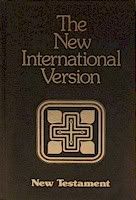Bible Abbreviation: NIVNT
ISBN: N/A
Publisher: Zondervan Bible Publishers – Grand Rapids, MI
Publication Date: 1973
Pages: 573
Binding: Hard
Size: 5.75” x 8.75’x 1.25”
This is a review of the First Edition of the New Testament of the New International Version published in 1973.
Features: The text is in a single column and in paragraph format with the verses designated with superscripted numerals. The NIVNT is adequately and effectively footnoted. However, it is lacking either concordance or maps. The style of the English employed cannot be said to be either American or British. Rather its style is more international in flavor.
Comments and Observations: The NIVNT is principally based on 2 manuscripts – the Vaticanus and the Sinaiticus. These are much older texts than what was readily available to translators prior to the 19th century. It is not a feeble argument that it is better to use manuscripts that are only 300 years separated from the original autographs. The theory is that the closer the text is to the original Greek manuscripts of the New Testament, the closer the translation will be to the precepts found in the original autographs. The problem is that the original autographs are not extant. Furthermore, there are literally thousands of differences between the Vaticanus and the Sinaiticus and hundreds of thousands of differences between the other available manuscripts. As with every translation, the translators were by necessity forced to make judgments and guesses as to which reading to use. It is up to the individual reader to determine how well the translators did with their assessments.
Over the past three decades the NIVNT, with its Old Testament cohort, has proven to be the most widely used and appreciated modern version of the Bible. The team of over one-hundred translators employed the dynamic equivalence (thought-for-thought) method of translation, rather than the formal equivalence (word-for-word) technique or the paraphrase approach to translation. The dynamic equivalence methodology is an attempt to strike a balance between literalness (NASB) and paraphrase (The Living Bible). This methodology conveys a more natural sounding modern English translation of the underlying Greek text. However, on the altar of readability, dynamic equivalence often forces the translator’s theology on the reader.
Old Testament Comparative Verse: N/A
New Testament Comparative Verse: Matthew 5:1-12.
1 Now when he saw the crowds, he went up on a mountainside and sat down. His disciples came to him, 2 and he began to teach them, saying:
3 "Blessed are the poor in spirit,
for theirs is the kingdom of heaven.
4 Blessed are those who mourn,
for they will be comforted.
5 Blessed are the meek,
for they will inherit the earth.
6 Blessed are those who hunger and thirst for righteousness,
for they will be filled.
7 Blessed are the merciful,
for they will be shown mercy.
8 Blessed are the pure in heart,
for they will see God.
9 Blessed are the peacemakers,
for they will be called sons of God.
10 Blessed are those who are persecuted
because of righteousness,
for theirs is the kingdom of heaven.
11 "Blessed are you when people insult you, persecute you and falsely say all kinds of evil against you because of me.
12 Rejoice and be glad, because great is your reward in heaven, for in the same way they persecuted the prophets who were before you.
Weaknesses: Sometimes, the theology of the translators made for poor translations. Romans 1:17 provides an excellent example. For comparison the King James Version reads:
“For therein is the righteousness of God revealed from faith to faith (emphasis added)”
The translators of the NIVNT decided to say that the Greek text was referencing the righteousness which God gives; not the righteousness of God’s character. In addition, they buried the original text with their own interpretation by promoting a “justification by faith” theological agenda. That is exegetically unfortunate. To be fair, later editions of the NIV have added the more literal "from faith to faith" in a footnote.
Another example is found in the footnote of 1 Timothy 3:11. Referring to deacons, the NIV has Paul writing, “In the same way, their wives are to be…”, which is the traditional translation. However, in a footnote, the NIV says, "Or way, deaconesses". The Greek word for “deaconess” is διάκονος while the Greek for “wife” is γυνή. I cannot find a single manuscript or variant reading listed in the United Bible Societies, Nestle-Aland or the recently published Society of Biblical Literature editions of the Greek New Testament which supports this. Simply put, διάκονος is not found in this verse! That the footnote suggests that this passage is referring to deaconesses, rather than to the wives of deacons, is misleading at best.
Strengths: For all its weaknesses, I think that the NIV is a fine translation. The NIV was the second translation – the New World Translation being the first – to deliberately leave the path blazed by the Tyndale family of Bibles. It is readable and fairly easy to understand. The language is current and mostly without archaic terms or anachronisms. One can find the gospel within it. One can teach the gospel from it. One can be lead to Jesus Christ by it.
The King James Version took a few revisions to get it to its present form. The NIV, too, is a work in progress. This year, the NIV presents its latest revision of the word of God in modern English. I shall review it presently.


No comments:
Post a Comment